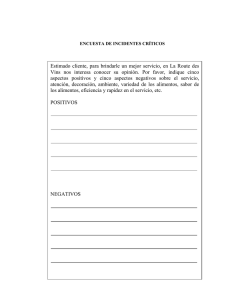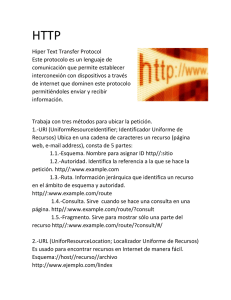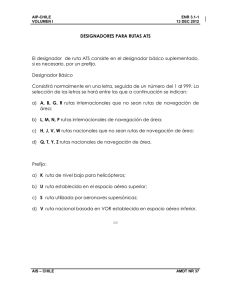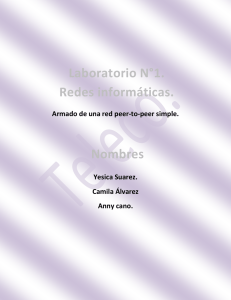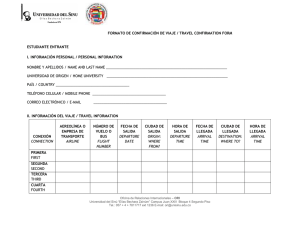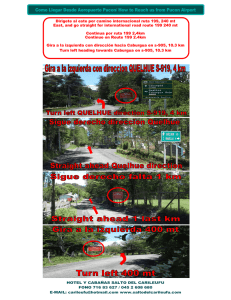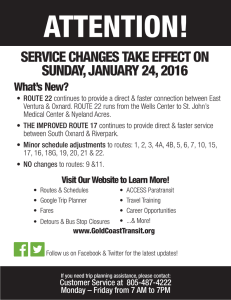Microsoft Word - C10A10.doc
Anuncio
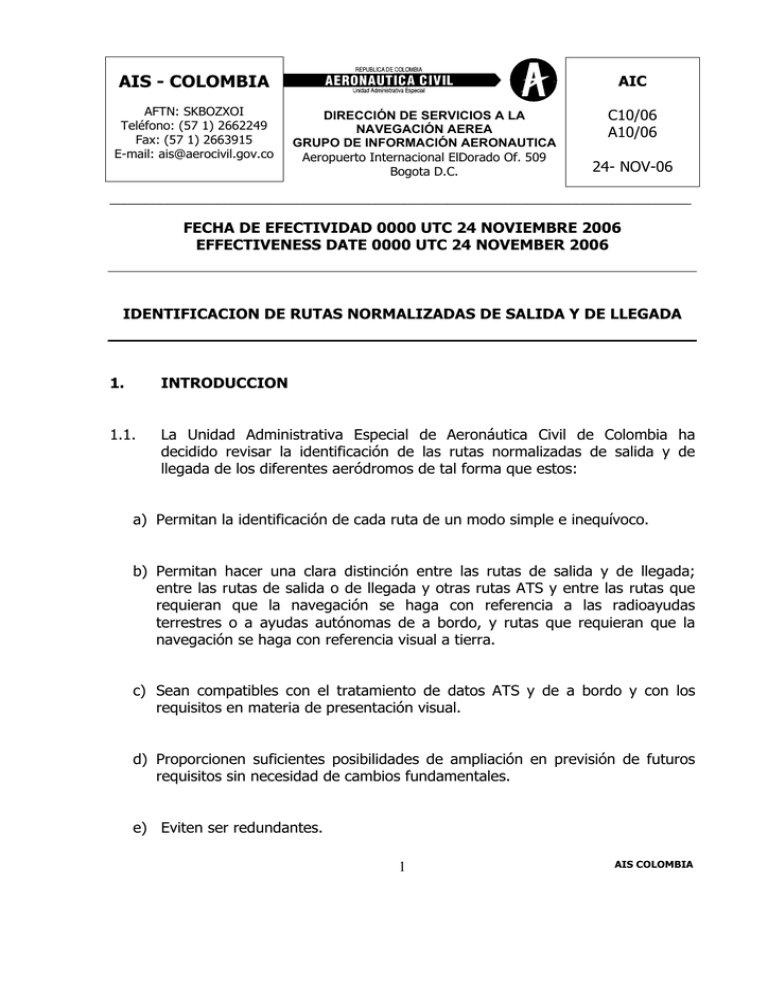
AIS - COLOMBIA AFTN: SKBOZXOI Teléfono: (57 1) 2662249 Fax: (57 1) 2663915 E-mail: [email protected] AIC DIRECCIÓN DE SERVICIOS A LA NAVEGACIÓN AEREA GRUPO DE INFORMACIÓN AERONAUTICA Aeropuerto Internacional ElDorado Of. 509 Bogota D.C. C10/06 A10/06 24- NOV-06 _________________________________________________________________________________ FECHA DE EFECTIVIDAD 0000 UTC 24 NOVIEMBRE 2006 EFFECTIVENESS DATE 0000 UTC 24 NOVEMBER 2006 IDENTIFICACION DE RUTAS NORMALIZADAS DE SALIDA Y DE LLEGADA 1. INTRODUCCION 1.1. La Unidad Administrativa Especial de Aeronáutica Civil de Colombia ha decidido revisar la identificación de las rutas normalizadas de salida y de llegada de los diferentes aeródromos de tal forma que estos: a) Permitan la identificación de cada ruta de un modo simple e inequívoco. b) Permitan hacer una clara distinción entre las rutas de salida y de llegada; entre las rutas de salida o de llegada y otras rutas ATS y entre las rutas que requieran que la navegación se haga con referencia a las radioayudas terrestres o a ayudas autónomas de a bordo, y rutas que requieran que la navegación se haga con referencia visual a tierra. c) Sean compatibles con el tratamiento de datos ATS y de a bordo y con los requisitos en materia de presentación visual. d) Proporcionen suficientes posibilidades de ampliación en previsión de futuros requisitos sin necesidad de cambios fundamentales. e) Eviten ser redundantes. 1 AIS COLOMBIA 1.2. En consideración de lo anteriormente expuesto se ha elaborado la presente Circular de Información Aeronáutica que detalla la composición de los designadores, tanto en lenguaje claro como en clave, de las diferentes rutas normalizadas de salida y de llegada, tanto para vuelo visual como para vuelo por instrumentos. 2. COMPOSICION DE LOS DESIGNADORES 2.1. DESIGNADOR EN LENGUAJE CLARO 2.1.1. El designador en lenguaje claro de una ruta normalizada de salida o de llegada constará de: a) Un indicador básico; seguido de b) Un indicador de validez; seguido de c) Un indicador de ruta, de ser necesario; seguido de d) La palabra “salida” o “llegada”; seguida de e) La palabra “visual”, si se ha determinado que la ruta sea utilizada por aeronaves que operen de conformidad con las reglas de vuelo visual (VFR). 2.1.2. El indicador básico será el nombre o el nombre en clave del punto significativo en el que termina la ruta normalizada de salida o en el que empieza la ruta normalizada de llegada. 2.1.3. El indicador de validez será un número de 1 a 9. 2.1.4. El indicador de ruta será una letra del alfabeto. No utilizará ni la letra “T” ni la letra “O”. AIS COLOMBIA 2 2.2. DESIGNADOR EN CLAVE 2.2.1. El designador en clave de una ruta normalizada de salida o de llegada, de vuelo por instrumentos o visual, constará: a) Del designador de clave o el nombre en clave del punto importante descrito en el literal a) del numeral 2.1.1.; seguido de b) Del indicador de validez mencionado en el literal b) del numeral 2.1.1.; seguido de c) Del indicador de ruta indicado en el literal c) del numeral 2.1.1., de ser necesario. 3. ASIGNACION DE DESIGNADORES 3.1. Se asignará un designador separado para cada ruta. 3.2. Para distinguir entre dos o más rutas que se refieran al mismo punto significativo (a las que, por lo tanto, se les ha asignado el mismo indicador básico), se asignará un indicador separado, como se describe en el numeral 2.1.4. a cada ruta. 4. ASIGNACION DE INDICADORES DE VALIDEZ 4.1. Se asignará un indicador de validez para cada ruta a fin de identificar la ruta actualmente vigente. 4.2. El primer indicador de validez que se asigne será el número “1”. 4.3. Cuando se modifique una ruta se asignará un nuevo indicador de validez, consistente en el siguiente número superior. Al número “9” seguirá el número “1”. 5. EJEMPLOS DE DESIGNADORES EN LENGUAJE CLARO Y EN CLAVE 5.1. Ejemplo 1: Ruta normalizada de salida para vuelo por instrumentos: a) Designador en lenguaje claro: ZIPAQUIRA UNO HOTEL SALIDA b) Designador en clave: ZIP 1 H 3 AIS COLOMBIA 5.1.1. Significado: Este designador identifica una ruta normalizada de salida para vuelo por instrumentos, que termina en el punto importante ZIPAQUIRA (indicador básico). ZIPAQUIRA es una instalación de radionavegación con la identificación ZIP (indicador básico del indicador en clave). El indicador de validez UNO (1 en el designador en clave) significa o bien que la versión original de la ruta sigue todavía vigente o bien que se ha hecho un cambio de la versión anterior NUEVE (9) a la versión vigente actualmente UNO (1). El indicador de ruta HOTEL (H) identifica una de varias rutas establecidas con referencia a ZIPAQUIRA, y es un signo específico asignado a esta ruta. 5.2. Ejemplo 2: Ruta normalizada de llegada para vuelo por instrumentos: a) Designador en lenguaje claro: UTICA DOS LLEGADA b) Designador en clave: UTICA 2 5.2.1. Significado: Este designador identifica una ruta normalizada de llegada para vuelo por instrumentos que empieza en el punto significativo UTICA (indicador básico). UTICA es un punto significativo no señalado por el emplazamiento de una radioayuda para la navegación y, por lo tanto, se le ha asignado un nombre en clave de cinco letras. El indicador de validez DOS (2 en el designador en clave) significa que se ha hecho un cambio de la versión anterior UNO (1) a la versión DOS (2), vigente actualmente. La ausencia de un indicador de ruta significa que se ha establecido únicamente una ruta – en este caso, una ruta de llegada – con referencia a UTICA. 5.3. Ejemplo 3: Ruta normalizada de llegada para vuelo visual: a) Designador en lenguaje claro: NEGRO UNO BRAVO SALIDA VISUAL b) Designador en clave: NEGRO 1 B 5.3.1. Significado: Este designador identifica una ruta normalizada de llegada para vuelos controlados VFR que comienza en NEGRO, un punto significativo no señalado por el emplazamiento de una radioayuda para la navegación y, por lo tanto, se le ha asignado un nombre en clave de cinco letras, en este caso una contracción de la población de Rionegro. El indicador de validez UNO (1 en el designador en clave) significa o bien que la versión original de la ruta sigue todavía vigente o bien que se ha hecho un cambio de la versión anterior NUEVE (9) a la versión vigente actualmente UNO (1). El indicador de ruta BRAVO (B) identifica una de varias rutas establecidas con referencia a NEGRO, y es un signo específico asignado a esta ruta. AIS COLOMBIA 4 6. UTILIZACION DE DESIGNADORES EN LAS COMUNICACIONES 6.1. En las comunicaciones orales, se utilizará únicamente el designador en lenguaje claro. 6.2. A los efectos de identificación de rutas, las palabras “salida”, “llegada” y “visual” descritas en los literales d) y e) del numeral 2.1.1. se consideran un elemento integrante del designador en lenguaje claro. 6.3. En las comunicaciones impresas o en clave, se utilizará únicamente el designador en clave. 7. PRESENTACION VISUAL DE LAS RUTAS Y PROCEDIMIENTOS AL CONTROL DE TRANSITO AEREO 7.1. Se dispondrá de una descripción detallada de cada ruta normalizada de salida, de llegada Y del procedimiento de aproximación en vigencia actualmente, incluidos el designador en lenguaje claro y el designador en clave, en los puestos de trabajo en los que se asignan las rutas o los procedimientos de aproximación a las aeronaves como parte de la autorización ATC, o que tengan alguna otra relación con el suministro de servicios de control de tránsito aéreo. IDENTIFICATION OF STANDARD DEPATURE AND ARRIVAL ROUTES 1. INTRODUCTION 1.1. The Unidad Administrativa Especial de Aeronautica Civil of Colombia has decided to check the identification of standard departure and arrival routes of the different aerodromes in such a way that these: a) Permit the identification of every route of a simple and unequivocal way. 5 AIS COLOMBIA b) Permit to do a clear difference between a departure and arrival route; between departure route or arrival route and other ATS routes and between routes that need that navigation is done by reference to terrestrial navaids or autonomous aid on board, and routes that need the navigation is done by visual reference to land. c) Be compatible with the treatment of ATS data and of on board and with the requirements as for visual presentation. d) Provide sufficient possibilities of amplification in anticipation of future requirements without need of fundamental changes. e) Avoid to be redundant. 1.2. In consideration of previously exposed there has been elaborated the present Aeronautical Information Circular that details the composition of the designators, in clear language and in key, of the different standard routes of departure and arrival, for visual flight and for instruments flight. 2. DESIGNATORS COMPOSITION 2.1. DESIGNATOR IN CLEAR LANGUAGE 2.1.1. The designator in clear language of a standard route of departure or arrival will consist of: a) b) c) d) e) Basic indicador; followed of An indicator of validity; followed of An indicator of route, of being necessary; followed of The "departure" or "Arrival" word; followed of The "visual" word, if one has determined that the route is used by aircrafts that operate of conformity with the rules of visual flight (VFR). 2.1.2. The basic indicator will be the name or the name in key of the significant point in the one that finishes the standard route of departure or in the one that begins the standard route of arrival. 2.1.3. The validity indicator will be a number from 1 to 9. 2.1.4. The route indicator will be a letter of the alphabet. Not even the letter will use "T" not even the letter "O". AIS COLOMBIA 6 2.2. DESIGNADOR IN KEY 2.2.1. The designador in key of standard route of departure or arrival, for instruments or visual flight, will consist: a) The designator of key or the name in key of the important point described in the literal a) of the numeral 2.1.1.; followed of b) The validity indicator mentioned in the literal b) of the numeral 2.1.1.; followed of c) The route indicator indicated in the literal c) of the numeral 2.1.1., of being necessary. 3. DESIGNATORS ASSIGNMENT 3.1. There will be assigned a designator separated for every route. 3.2. To distinguish between two or more routes that refer to the same significant point (to those that, therefore, the same basic indicator has assigned to them), a separated indicator will be assigned, since 2.1.4. are described in the numeral to every route. 4. ASSIGNMENT OF INDICATORS OF VALIDITY 4.1. An indicator of validity will be assigned for every route in order to identify the route in force. 4.2. The first indicator of validity that is assigned will be the number "1". 4.3. When a route is modified there will be assigned a new indicator of validity, consisting of the following upper number. To the number "9" it will continue the number "1". 5. DESIGNATORS EXAMPLES IN CLEAR LANGUAGE AND IN KEY 5.1. Example 1: Standard route of departure for flight by instruments: a) Designator in clear language: ZIPAQUIRA ONE HOTEL DEPARTURE b) Designator in key: ZIP 1 H 7 AIS COLOMBIA 5.1.1. Meaning: This designator identifies a standard route of departure for flight by instruments, which finishes in the important point ZIPAQUIRA (basic indicator). ZIPAQUIRA is an installation of radio navigation with the identification ZIP (basic indicator of the indicator in key). The indicator of validity ONE (1 in the designator in key) means or that the original version of the route is in force or that there has done a change of the previous version NINE (9) to the actually in force version ONE (1). The indicator of route HOTEL (H) identifies one of several routes established with reference to ZIPAQUIRA, and is a specific sign assigned to this route. 5.2. Example 2: Standard route of arrival for flight by instruments: a) Designador in clear language: UTICA TWO ARRIVAL b) Designador in key: UTICA 2 5.2.1. Meaning: This designador identifies a standard route of arrival for flight by instruments that begin in the significant point UTICA (basic indicator). UTICA is a significant point not distinguished by the emplacement of a navaid for the navigation and, therefore, a name has been assigned in key of five letters. The indicator of validity TWO (2 in the designador in key) means that there has been done a change of the previous version ONE (1) to the version TWO (2), actually in force. The absence of an indicator of route means that a route has been established only - in this case, a route of arrival - by reference to UTICA. 5.3. Example 3: Standard route of arrival for visual flight: a) Designador in clear language: NEGRO ONE BRAVO VISUAL DEPARTURE b) Designador in key: NEGRO 1 B 5.3.1. Meaning: This designador identifies a standard route of arrival for controlled VFR flights that begins in NEGRO, a significant point not distinguished by the emplacement of a navaid for the navigation and, therefore, has assigned a name in key of five letters, in this case a contraction of the town of Rionegro. The indicator of validity ONE (1 in the designador in key) means or that the original version of the route is in force or that there has done a change of the previous version NINE (9) to the actually in force version ONE (1). The BRAVO indicator of route (B) identifies one of several routes established with reference to NEGRO, and is a specific sign assigned to this route. 6. DESIGNATORS UTILIZATION IN THE COMMUNICATIONS 6.1. In the oral communications, the designador will be in use only in clear language. AIS COLOMBIA 8 6.2. To identification of routes, the words "departure", "arrival" and "visual" described in the literal d) and e) of the numeral 2.1.1. They are considered to be an integral element of the designador in clear language. 6.3. In the printed communications or in key, the designador will be in use only in key. 7. VISUAL PRESENTATION OF ROUTES AND PROCEDURES TO THE AIR TRAFFIC CONTROL 7.2. Will display of a detailed description of every Standard route of departure, of arrival and of approach procedure actually in force, included the designator in clear language and the designator in key, in the working places in those who assign the routes or the approach procedure to the aircraft as part of the authorization ATC, or any other relation with the supply of air traffic control services. 9 AIS COLOMBIA
